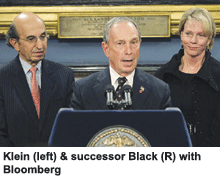The number of overseas students in the US is continuing to rise, with recent growth driven by a surge in recruitment from China. According to figures released in mid-November, the number of Chinese students in the US rose by 30 percent last year, an increase seen as evidence of growth in the Asian nation’s middle class and its appetite for higher education.
The figures are detailed in an analysis of student movements between the US and the rest of the world, published by the Institute of International Education (IIE). The IIE, a non-profit body that helps administer the Fulbright international-exchange programme, publishes its Open Doors report annually with support from the US department of state’s bureau of educational and cultural affairs.
In 2009-10, the number of overseas students enroled in US institutions rose by 2.9 percent to 690,923, the report shows. This is down from a 7.7 percent rise in 2008-09. IIE says that growth in 2009-10 was “primarily driven by a 30 percent increase in Chinese student enrolment in the US to a total of nearly 128,000 students”, making China leading exporter to the US academy.
Peggy Blumenthal, chief operating officer at the IIE, says lower overall growth in the US’ intake is evidence of students’ financial concerns in light of the economic crisis. She adds that the increase in students coming from China, where economic growth has remained strong, stems from the country’s “growing middle class, a growing desire for students to get the best education in the world”. Many in China find there are “not enough places in their own country that provide high-quality undergraduate education”, she says.
Allan Goodman, president of the IIE, highlights the broader significance of educational links between the US and Asia. China, India and South Korea account for 44 percent of all overseas students in the US. China and India, the world’s most populous countries with the fastest growing economies, are also the largest sources of overseas students in the UK.
According to Dr. Goodman, the US’ educational links with the regions are “going to be as significant in this century as the Silk Road was 1,000 years ago”, pointing to the international backgrounds of recent US Nobel prize winners in the sciences as evidence.
As to whether rapidly rising fees in many US institutions could act as a deterrent, Goodman says there’s “great diversity” in charges. Moreover the option to attend community colleges early in their courses before moving on to university will become more popular with overseas undergraduates, he predicts.
Untimely resignation
One parent outside PS 58, a public school in Queens, was glad to see the back of Joel Klein, who in mid-November unexpectedly resigned as the city’s schools chancellor to join Rupert Murdoch’s News Corp. But others appreciate how much he has improved New York’s school system. When Klein took the job in 2002, graduation rates were low and test scores abysmal. Michael Bloomberg, the mayor who appointed him, said the system was “in a state of emergency”.
 Bloomberg wanted Klein to shake things up, and he did. He pushed for a big increase in the number of New York’s charter schools. He devolved control of government-run schools to their head teachers, who were made more accountable. Schools were graded, and Klein unblinkingly closed those that were failing. An academy was set up to train school heads.
Bloomberg wanted Klein to shake things up, and he did. He pushed for a big increase in the number of New York’s charter schools. He devolved control of government-run schools to their head teachers, who were made more accountable. Schools were graded, and Klein unblinkingly closed those that were failing. An academy was set up to train school heads.
New York’s high-school graduation rate increased every year he was in charge; it is now 20 percent higher than it was four years ago, compared with just 3 percent higher for the rest of the state. Test scores have improved. The Los Angeles-based Broad Foundation declared in 2007 that New York was the country’s most improved urban school district.
Indeed, the city has become a laboratory for school reform, with experimental programmes paid for by philanthropic organisations. This allowed Klein to avoid the political battles he would have encountered if taxpayers had paid for them. Still, the pugnacious former prosecutor had plenty of other fights on his hands, especially with parents who backed legal moves to keep closing schools open and with the teachers’ unions.
Klein’s dispiriting resignation comes just weeks after Michelle Rhee stepped down as Washington DC’s chancellor. She too overhauled her district, closing failing schools while improving test scores. She convinced a reluctant teacher’s union to agree to a pay-for-performance system. But her reforms were the central issue in the recent mayoral election, costing the mayor who appointed her his job.
Bloomberg has filled New York’s gap with Cathie Black, the head of Hearst Magazines, a publishing company. She is said to be a good manager, and charming as well. But for someone with no background in education or public service, she will have a lot to manage: 135,000 employees, a $23 billion (Rs.103,500 crore) budget and 1.1 million pupils. Wish her luck.
(Excerpted and adapted from The Economist & Times Higher Education)